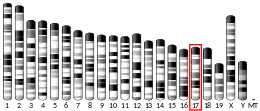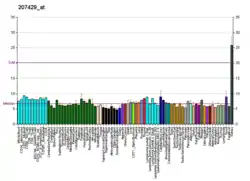Solute carrier family 22 member 2 (also termed OCT2 or organic cation transporter-2[5]) is a protein that in humans is encoded by the SLC22A2 gene.[6][7]
Polyspecific organic cation transporters in the liver, kidney, intestine, and other organs are critical for elimination of many endogenous small organic cations as well as a wide array of drugs and environmental toxins. This gene is one of three similar cation transporter genes located in a cluster on chromosome 6. The encoded protein contains twelve putative transmembrane domains and is a plasma integral membrane protein. It is found primarily in the kidney, where it may mediate the first step in cation reabsorption.[7]
See also
References
- 1 2 3 GRCh38: Ensembl release 89: ENSG00000112499 - Ensembl, May 2017
- 1 2 3 GRCm38: Ensembl release 89: ENSMUSG00000040966 - Ensembl, May 2017
- ↑ "Human PubMed Reference:". National Center for Biotechnology Information, U.S. National Library of Medicine.
- ↑ "Mouse PubMed Reference:". National Center for Biotechnology Information, U.S. National Library of Medicine.
- ↑ "SLC22A2 solute carrier family 22 member 2 [Homo sapiens (human)] - Gene - NCBI".
- ↑ Koehler MR, Wissinger B, Gorboulev V, Koepsell H, Schmid M (Jun 1998). "The two human organic cation transporter genes SLC22A1 and SLC22A2 are located on chromosome 6q26". Cytogenet Cell Genet. 79 (3–4): 198–200. doi:10.1159/000134720. PMID 9605850.
- 1 2 "Entrez Gene: SLC22A2 solute carrier family 22 (organic cation transporter), member 2".
Further reading
- Berkhout B, Jeang KT (1992). "Functional roles for the TATA promoter and enhancers in basal and Tat-induced expression of the human immunodeficiency virus type 1 long terminal repeat". J. Virol. 66 (1): 139–49. doi:10.1128/JVI.66.1.139-149.1992. PMC 238269. PMID 1727476.
- Jeang KT, Chun R, Lin NH, et al. (1993). "In vitro and in vivo binding of human immunodeficiency virus type 1 Tat protein and Sp1 transcription factor". J. Virol. 67 (10): 6224–33. doi:10.1128/JVI.67.10.6224-6233.1993. PMC 238044. PMID 7690421.
- Liu YZ, Lania L, Latchman DS (1997). "Functional interaction between the HIV-1 Tat transactivator and the inhibitory domain of the Oct-2 cellular transcription factor". AIDS. 10 (12): 1323–9. doi:10.1097/00002030-199610000-00003. PMID 8902060. S2CID 11659500.
- Liu YZ, Latchman DS (1997). "The octamer-binding proteins Oct-1 and Oct-2 repress the HIV long terminal repeat promoter and its transactivation by Tat". Biochem. J. 322 (1): 155–8. doi:10.1042/bj3220155. PMC 1218171. PMID 9078256.
- Gorboulev V, Ulzheimer JC, Akhoundova A, et al. (1997). "Cloning and characterization of two human polyspecific organic cation transporters". DNA Cell Biol. 16 (7): 871–81. doi:10.1089/dna.1997.16.871. PMID 9260930.
- Busch AE, Karbach U, Miska D, et al. (1998). "Human neurons express the polyspecific cation transporter hOCT2, which translocates monoamine neurotransmitters, amantadine, and memantine". Mol. Pharmacol. 54 (2): 342–52. doi:10.1124/mol.54.2.342. PMID 9687576.
- Verhaagh S, Schweifer N, Barlow DP, Zwart R (1999). "Cloning of the mouse and human solute carrier 22a3 (Slc22a3/SLC22A3) identifies a conserved cluster of three organic cation transporters on mouse chromosome 17 and human 6q26-q27". Genomics. 55 (2): 209–18. doi:10.1006/geno.1998.5639. PMID 9933568.
- Gründemann D, Schömig E (2000). "Gene structures of the human non-neuronal monoamine transporters EMT and OCT2". Hum. Genet. 106 (6): 627–35. doi:10.1007/s004390050035. PMID 10942111.
- Pietig G, Mehrens T, Hirsch JR, et al. (2001). "Properties and regulation of organic cation transport in freshly isolated human proximal tubules". J. Biol. Chem. 276 (36): 33741–6. doi:10.1074/jbc.M104617200. PMID 11447227.
- Boehm J, He Y, Greiner A, et al. (2001). "Regulation of BOB.1/OBF.1 stability by SIAH". EMBO J. 20 (15): 4153–62. doi:10.1093/emboj/20.15.4153. PMC 149152. PMID 11483518.
- Barendt WM, Wright SH (2002). "The human organic cation transporter (hOCT2) recognizes the degree of substrate ionization". J. Biol. Chem. 277 (25): 22491–6. doi:10.1074/jbc.M203114200. PMID 11953440.
- Urakami Y, Akazawa M, Saito H, et al. (2002). "cDNA cloning, functional characterization, and tissue distribution of an alternatively spliced variant of organic cation transporter hOCT2 predominantly expressed in the human kidney". J. Am. Soc. Nephrol. 13 (7): 1703–10. doi:10.1097/01.ASN.0000019413.78751.46. PMID 12089365.
- Leabman MK, Huang CC, Kawamoto M, et al. (2003). "Polymorphisms in a human kidney xenobiotic transporter, OCT2, exhibit altered function". Pharmacogenetics. 12 (5): 395–405. doi:10.1097/00008571-200207000-00007. PMID 12142729.
- Cetinkaya I, Ciarimboli G, Yalçinkaya G, et al. (2003). "Regulation of human organic cation transporter hOCT2 by PKA, PI3K, and calmodulin-dependent kinases". Am. J. Physiol. Renal Physiol. 284 (2): F293–302. doi:10.1152/ajprenal.00251.2002. PMID 12388397. S2CID 38608510.
- Strausberg RL, Feingold EA, Grouse LH, et al. (2003). "Generation and initial analysis of more than 15,000 full-length human and mouse cDNA sequences". Proc. Natl. Acad. Sci. U.S.A. 99 (26): 16899–903. Bibcode:2002PNAS...9916899M. doi:10.1073/pnas.242603899. PMC 139241. PMID 12477932.
- Gründemann D, Hahne C, Berkels R, Schömig E (2003). "Agmatine is efficiently transported by non-neuronal monoamine transporters extraneuronal monoamine transporter (EMT) and organic cation transporter 2 (OCT2)". J. Pharmacol. Exp. Ther. 304 (2): 810–7. doi:10.1124/jpet.102.044404. PMID 12538837. S2CID 11496882.
- Bottalico B, Larsson I, Brodszki J, et al. (2004). "Norepinephrine transporter (NET), serotonin transporter (SERT), vesicular monoamine transporter (VMAT2) and organic cation transporters (OCT1, 2 and EMT) in human placenta from pre-eclamptic and normotensive pregnancies". Placenta. 25 (6): 518–29. doi:10.1016/j.placenta.2003.10.017. PMID 15135235.
- Lips KS, Volk C, Schmitt BM, et al. (2005). "Polyspecific cation transporters mediate luminal release of acetylcholine from bronchial epithelium". Am. J. Respir. Cell Mol. Biol. 33 (1): 79–88. CiteSeerX 10.1.1.327.6767. doi:10.1165/rcmb.2004-0363OC. PMID 15817714.
- Jiang W, Prokopenko O, Wong L, et al. (2005). "IRIP, a new ischemia/reperfusion-inducible protein that participates in the regulation of transporter activity". Mol. Cell. Biol. 25 (15): 6496–508. doi:10.1128/MCB.25.15.6496-6508.2005. PMC 1190334. PMID 16024787.
This article incorporates text from the United States National Library of Medicine, which is in the public domain.




